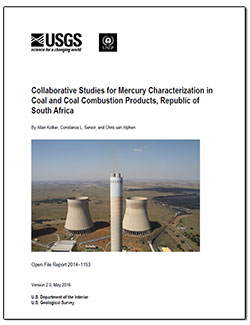 Summary Summary
Mercury (Hg) analyses were obtained for 42 samples of feed coal provided by Eskom, the national electric utility of South Africa, representing all 13 coal-fired power stations operated by Eskom in South Africa. This sampling includes results for three older power stations returned to service starting in the late 2000s. These stations were not sampled in the most recent previous study. Mercury concentrations determined in the present study are similar to or slightly lower than those previously reported, and input Hg for the three stations returned to service is comparable to that for the other 10 power stations. Determination of halogen contents of the 42 feed coals confirms that chlorine contents are generally low, and as such, the extent of Hg self-capture by particulate control devices (PCDs) is rather limited. Eight density separates of a South African Highveld (#4) coal were also provided by Eskom, and these show a strong mineralogical association of Hg (and arsenic) with pyrite. The density separates were used to predict Hg and ash contents of coal products used in South Africa or exported. A suite of 48 paired samples of pulverization-mill feed coal and fly ash collected in a previous (2010) United Nations Environment Programme-sponsored study of emissions from the Duvha and Kendal power stations was obtained for further investigation in the present study. These samples show that in each station, Hg capture varies by boiler unit and confirms that units equipped with fabric filters for air pollution control are much more effective in capturing Hg than those equipped with electrostatic precipitators. Apart from tracking the performance of PCDs individually, changes resulting in improved mercury capture of the Eskom fleet are discussed. These include Hg reduction through coal selection and washing, as well as through optimization of equipment and operational parameters. Operational changes leading to increased mercury capture include increasing mercury adsorption on unburned carbon and minimizing the concentration of sulfuric acid vapor in the flue gas. Equipment options for improving Hg capture include addition of fabric filters, use of halogenated sorbents, and addition of flue gas desulfurization (FGD) scrubbers, listed in order of increasing cost. The capital cost of adding FGD scrubbers to existing plants is probably too high to be justified on the grounds of Hg removal alone. However, if future regulations require reductions in sulfur dioxide emissions, and FGDs are installed to meet these standards, further reduction in Hg emissions will be a co-benefit of this installation.
In this revised version, corrected results for the suite of 42 samples of feed coal and 8 density separates determined by inductively coupled plasma-mass spectrometry (ICP-MS) replace results originally reported in the 2014 version of this report. In many cases, especially for the transition metals, values reported here are lower than those originally reported, and in some cases, the corrected results are less than 50 percent of their original values. Note that results for mercury (Hg) and halogens contained in the original report are unaffected by revisions to ICP-MS data included here. This revised version also includes the following updates: (1) data for selenium, which were not available for inclusion in the original publication, are now provided; (2) results for ICP-MS trace element data are expressed here on a whole-coal dry basis to facilitate comparison with published results for coals elsewhere; and (3) the text has been updated to take into account the U.S. Supreme Court decision of June 29, 2015, which puts on hold implementation of U.S. Environmental Protection Agency Mercury and Air Toxics Standards in the United States.
|
Part or all of this report is presented in Portable Document Format (PDF). For best results viewing and printing PDF documents, it is recommended that you download the documents to your computer and open them with Adobe Reader. PDF documents opened from your browser may not display or print as intended. Download the latest version of Adobe Reader, free of charge. More information about viewing, downloading, and printing report files can be found here.
|